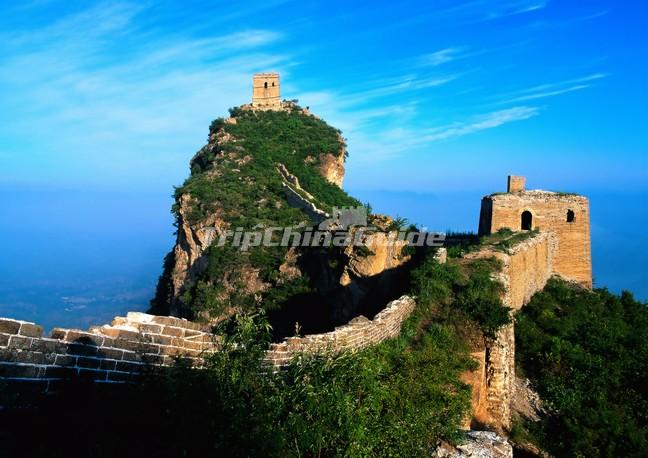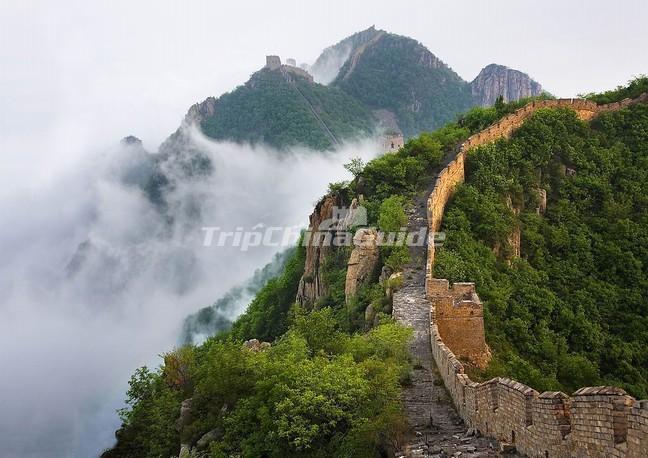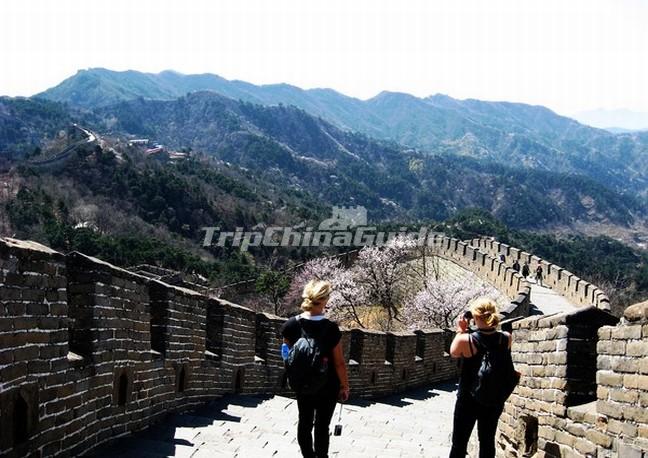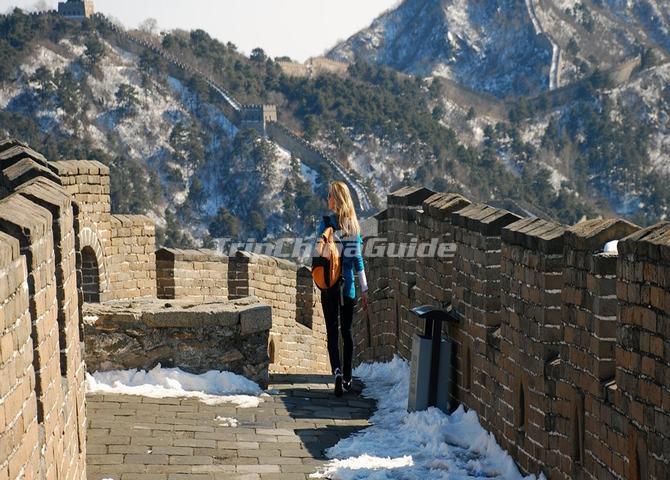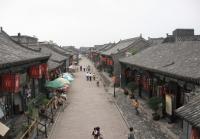Facts about the Great Wall
The Great Wall was continuously built from the 3rd century BC to the 17th century AD on the northern border of the country as the great military defence project of successive Chinese Empires, with a total length of more than 20,000 kilometers. The Great Wall begins in the east at Shanhaiguan in Hebei province and ends at Jiayuguan in Gansu province to the west. Its main body consists of walls, horse tracks, watches towers, and shelters on the wall, and includes fortresses and passes along the Wall.
The Great Wall reflects collision and exchanges between agricultural civilizations and nomadic civilizations in ancient China. It provides significant physical evidence of the far-sighted political strategic thinking and mighty military and national defence forces of central empires in ancient China, and is an outstanding example of the superb military architecture, technology and art of ancient China. It embodies unparalleled significance as the national symbol for safeguarding the security of the country and its people.
History of the Great Wall
According to legend, the Great Wall was built by the first emperor of the Qin Dynasty, Qin Shi Huang (Reigned 221-210 BC), though historical records trace the true origin of the wall to defensive fortifications built in the fifth century BC From the statement "Square walls surround the Kingdom of Chu," we can trace walls with a total length of 500 kilometers in what is now Henan Province dating back to the Eastern Zhou Dynasty (770-256 BC). In addition to Chu, the kingdoms of Qin, Qi, Wei, Zhao, Han and Yan all had their own separate defensive walls spread about through the Yellow and Yangtze River basins, running in different directions and beginning and ending abruptly. The walls of this period bear little relationship to the wall of today with its predominantly east-west configuration.
In 221 BC, the armies of Qin conquered the abovementioned six kingdoms and unified China. Qin Shi Huang ordered the demolition of the walls separating these kingdoms and rebuilt a new "Great Wall," based on the walls protecting the northern frontiers of Yan, Zhao and Qin. According to the Records of the Historian (shiji), written approximately 100 BC, "General Meng Tian mobilized 300,000 laborers and built a great wall which followed the contour of the land, taking advantage of natural defenses." This wall extended more than 6,000 kilometers from Lintiao (in Gansu Province) to Liaodong. Thus the general plan of today's Great Wall was laid down during the Qin Dynasty (221-206 BC).
During the Han Dynasty (206 BC- AD 220) which followed the Qin, in addition to making improvements in the Qin wall, the Han emperors constructed a separate outer wall north of the Yinshan Range with a total length of 10,000 kilometers.
This was the longest single wall built in ancient China. After the fall of the Han Dynasty, the wall gradually decayed into ruins. In 1368, the founding year of the Ming Dynasty, Emperor Taizu commanded his general Xu Da to direct the reconstruction of the Great Wall. Beginning at the Juyong Pass, the work went on for more than 100 years. Based on the general dimensions of the Qin Wall, the Ming wall stretched from its westernmost point at the Jiayu Pass more than 6,000 kilometers east to the Yalu River. The section, which lies between the Jiayu and Shanhai, passes remains in good condition today and is known throughout the world as the Great Wall of China.
Military Value of the Great Wall
Judging from the standpoint of present day warfare, the Great Wall can't be mentioned to become a defense network of any fantastic military value. Nevertheless when man's chief military weapons had been the sword, arrows, bows, ge (hook weapon) and mao (spear), the predicament was fairly different. The Great Wall provides superb defense since it had been created in strategic places. It played an important role then. Several have been instance in ancient when it took an incredibly prolonged time to consider a city or mountain pass. There were even circumstances when people who launched the assault had to retreat with no battle, whenever they saw the strong defense work of the city. Within the Central
Plain of China this kind of firm and large defense perform proved to be extremely beneficial to foil the attacks of mobile cavalry, which roamed from one place to another.
Being an outcome of steady construction and making improvement through the Ming Dynasty the Great Wall became an ideal defense network, whereby the central Chinese authority could, by way of a variety of administrative and military amounts of organization, attain the essential or grass root military unit, down to each soldier guarding the Great Wall. The Ming Dynasty overthrew the Yuan, acquiring ruling power throughout the nation. The authentic rulers, even so, only retreated to their former positions. They were not destroyed. This made it possible for them to make a come-back. Under these conditions, the Great Wall grew to become a significant protection issue for that Ming Dynasty.
Top 6 FAQ on the Great Wall
1.
Q: Where is the Great Wall of China?
A: The Great Wall starts from the shanghai pass at the seaside in the Hebei province to the Jiayu pass in Gansu province. The sites of the Great Wall stretch across 15 provinces of China, Tianjin, Qinghai, Shandong and Inner Mongolia, etc.
2.
Q: How was the Great Wall built?
A: The construction of the Great Wall was mainly depended on human labor. The large stones, earth, wood and bricks were carried on human’s back or lifted by the bar. Simple machines were also used to create the Wall, such as varied handcarts, crowbars and wheels. Animals were also used to transport the materials, just because some sections of the Great Wall were built on the crests, it was hard for a man to carry the heavy materials to these places.
3.
Q: How long is the Great Wall of China?
A: According to the State Administration of Cultural Heritage and National Bureau of Surveying and Mapping Agency in 2009, the latest data of the length of the Great Wall is 8851.8 km, which is 2000km longer than the past data.
4.
Q: Who built the Great Wall of China?
A: According to records, Emperor Qin shi huang ordered millions of the people to construct the Great Wall, including the workers, famous, soldiers and slaves.
5.
Q: Why the Great Wall is built?
A: As early as 7th century BC, Chu dynasty firstly built the Great Wall to stop the invasion from other countries and it opened the curtain of constructing the Great Wall in the history of China. During the Warring States Period, Qi, Wei, Zhao, Qin, Yan and Zhongshan had also built the Great Wall. The Great Wall was the greatest military defense project in the history, and it was also the guarantee of the peace and stability of ancient society and agriculture.
6.
Q: Can the Great Wall be seen from the outer space?
A: The Great Wall is great, but you can’t see it from the space. The average width of the Great Wall is no more than 10 meters, and it can be easily hidden by the surroundings. It is difficult to see it from 20km high by naked eye, not to say 400km from the spacecraft.
Existing Wall
Now, the existing wall is Badaling Great Wall, Mutianyu Great Wall, Simatai Great Wall, Gubeikou Great Wall, Jiankou Great Wall, Jinshanling Great Wall, Shanhaiguan Great Wall, Jiayuguan Great Wall,Tiger Mountain Great Wall, Nine door Great Wall, Datong Great Wall, Juyongguan Pass, etc.
Major Scenic spots of Excellent Wall
1.Badaling
Badaling is the most crowded site to the Great Wall, largely because it is the easiest to access. Dozens of buses, both tour and public, drop off passengers by the hundreds each day. Visitors who go in the afternoon should solve problems less crowded. Badaling has handicapped access towards the Wall, and quite a few restaurants and souvenir stands. It is home to the Fantastic Wall Museum which facts the history of the wall in displays and a theater presentation; the museum is closed on Mondays.
Ticket for the scene spot of Badaling area on the Great Wall: Price is 45 Yuan. Young children pay 25 Yuan. The ticket can be used as postcard. In the ticket is already a printed stamp. Also incorporated is actually a tourist commemoration of the Great Wall: 4 stamps with paintings on the Wall.
2. Shanhaiguan
Shanhaiguan could be the eastern terminus of the Great Wall. The final tower in the Wall juts out to the Bohai Sea. Due to the fact that it's a seaside town, this area is extremely crowded in the summer, but winter visitors may locate themselves alone on the Wall. Shanhaiguan, acknowledged as "Laolongtou" or "old dragon head," features a smaller sized Excellent Wall Museum. The town is about a five-hour train trip north of Beijing, and can make a wonderful overnight tour for individuals who desire to escape the hustle and bustle of the Chinese capital for a couple of hours.
3. Juyongguan
Juyongguan or Juyonguan Pass is located in an 18 kilometer-long valley named "Guangou" which is inside Changping County more than 50 kilometers from Beijing City. It is one of the three greatest passes of the Great Wall of China (The other two passes are Jiayuguan Pass and Shanhai Pass).
A Legend on the Great Wall of China
The story happened during the Qin Dynasty (221BC-206BC). There was once an old man named Meng who lived in the southern part of the country with his wife. One spring, Meng sowed a seed of bottle gourd in his yard. The bottle gourd grew up bit by bit and its vines climbed over the wall and entered his neighbor Jiang's yard. Like Meng, Jiang had no children and so he became very fond of the plant. He watered and took care of the plant. With tender care of both men, the plant grew bigger and bigger and gave a beautiful bottle gourd in autumn. Jiang plucked it off the vine, and the two old men decided to cut the gourd and divide it by half. To their surprise when they cut the gourd a pretty and lovely girl was lying inside! They felt happy to have a child and both loved her very much, so they decided to bring the child up together. They named the girl Meng Jiangnu, which means Meng and Jiang's daughter.
As time went by, Meng Jiangnu grew up and became a beautiful young woman. She was very smart and industrious. She took care of old Meng and Jiang's families, washing the clothes and doing the house work. People knew that Meng Jiangnu was a good girl and liked her very much. One day while playing in the yard, Meng Jiangnu saw a young man hiding in the garden. She called out to her parents, and the young man came out.
At that time, Emperor Qin Shihuang (the first emperor of Qin) announced to build the Great Wall. So lots of men were caught by the federal officials. Fan Qiliang was an intellectual man and very afraid of being caught, so he went to Meng's house to hide from the officials. Meng and Jiang liked this good-looking, honest, and good-mannered young man. They decided to wed their daughter to him. Both Fan Qiliang and Meng Jiangnu accepted happily, and the couple was married several days later. However, three days after their marriage, officials suddenly broke in and took Fan Qiliang away to build the Great Wall in the north of China.
It was a hard time for Meng Jiangnu after her husband was taken away - she missed her husband and cried nearly every day. She sewed warm clothes for her husband and decided to set off to look for him. Saying farewell to her parents, she packed her luggage and started her long journey. She climbed over mountains and went through the rivers. She walked day and night, slipping and falling many times, but finally she reached the foot of the Great Wall at the present Shanhaiguan Pass.
Upon her arrival, she was eager to ask about her husband. Bad news came to her, however, that Fan Qiliang had already died of exhaustion and was buried into the Great Wall! Meng Jiangnu could not help crying. She sat on the ground and cried and cried. Suddenly with a tremendous noise, a 400 kilometer-long (248-mile-long) section of the Great Wall collapsed over her bitter wail. The workmen and supervisors were astonished. Emperor Qin Shihuang happened to be touring the wall at that exact time, and he was enraged and ready to punish the woman.
However, at the first sight of Meng Jiangnu Emperor Qin Shihuang was attracted by her beauty. Instead of killing her, the Emperor asked Meng Jiangnu to marry him. Suppressing her feeling of anger, Meng Jiangnu agreed on the basis of three terms. The first was to find the body of Fan Qiliang, the second was to hold a state funeral for him, and the last one was to have Emperor Qin Shihuang wear black mourning for Fan Qiliang and attend the funeral in person. Emperor Qin Shihuang thought for a while and reluctantly agreed. After all the terms were met, Emperor Qin Shihuang was ready to take her to his palace. When the guarders were not watching, she suddenly turned around and jumped into the nearby Bohai Sea.
This story tells of the hard work of Chinese commoners, as well as exposes the cruel system of hard labor during the reign of Emperor Qing Shihuang. The Ten-Thousand-Li Great Wall embodied the power and wisdom of the Chinese nation. In memory of Meng Jiangnu, later generations built a temple, called the Jiangnu Temple, at the foot of the Great Wall in which a statue of Meng Jiangnu is located. Meng Jiangnu's story has been passed down from generation to generation.
Four Tips for visiting the Great Wall
1. Choose the best time to visit Great Wall of China
In Beijing, all the sections of the Wall are open to travelers all 12 months round. The ideal months for the Fantastic Wall hike fall on spring, early summer, autumn- later March, April, May, June, September, October and early November. If you take place to go to the Wall in summer season- later on June, July and August, be ready for heat stroke prevention -sunglasses, sun cream, sun block, hat, water. Winter Wonderful Wall Hike is really a bit difficult as the result of frozen climate in later December, January and early February annually in Beijing. You are recommended to dress warmly- winter hat with ear flap, ear warmers, gloves, scarf, warm jackets and the winter accessories. The Fantastic Wall hike is unattainable only because the street entry to sections is blocked due to the hefty snow. If you strategy to do the hike in winter, we do advise you check the weather report.
2. Steer clear of weekends or public holidays
It's better to hike the Wall through the weekdays as an alternative to weekends. Strongly advise you not to pay a visit to the Wall in the course of China public holidays. On these unique days you are going to waste a lot of the valuable time on the way you're your hotel towards the Wall. To the Wall, you have to consider group photos considering that you will find a great amount of individuals around the Wall.
3. Choose the right bit of the Wall
You will find approximate eight bits of the Wall around Beijing. Five of the eight bits of the Wall are legally open to tourists home and abroad. "Legally open" signifies these sections of the Wall are tamed, repaired and managed by a neighborhood Excellent Wall administration bureau. Within its administration, the entrance expenses are collected, a police station is set up and protection guides are dotted along Wall. These "legal" sections of the Wall are Juyongguan, Badaling, Mutianyu, Jinshanling, Simatai. Jiankou and Gubeikou usually are not open to tourists due to their wildness and treacherousness. It is said that Huanghuacheng Great Wall will probably be open towards the public sooner or later.
Below will be the tips for picking the right bit of the Great Wall you most like:
1) In case you have considerably time, you should choose Juyongguan Great Wall to visit. Beacause there are fewer people there.
2) if you want to see one of the most stunning area of the Wall in Beijing, visit Badaling Great Wall.
3) if you want to see the Wall with green scenery and atmosphere, visit Mutianyu Great Wall.
4) if you want to hike the wild and unique bits of the Wall, pay a visit to either Jinshanling Great Wall or Simtai Great, or put them together.
5) Huanghuacheng Fantastic Wall not nevertheless opened
6) Jiankou and Gubeikou sections of the Wall are forbidden to hike in accordance with the official rule and regulations concerned.
4. Choose the right Great Wall transportation
Take a Public Bus to the Great Wall
Badaling Great Wall: Take bus 877 (RMB 12) from Beijing Deshengmen or the train from Beijing North Train Station stations (RMB 17).
Juyongguan Great Wall: Take bus 877 (RMB 12) from Beijing Deshengmen or the train from Beijing North Train Station stations (RMB 17).








